Motorhome damp and condensation control
Motorhome damp can build up over time, whether it’s sat in storage or being used, so it’s important to take steps to reduce moisture and keep your vehicle well-ventilated.
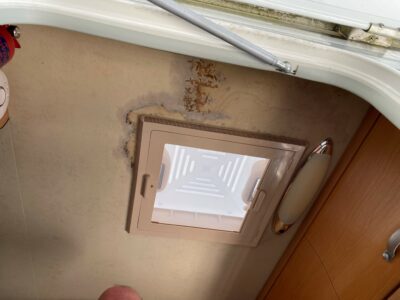
Over the colder months, condensation can increase dramatically, but with a bit of extra care it can be reduced or better still, prevented.
Catching any sign of motorhome damp early, or worse still water ingress, will be less costly to resolve in the long run.
It’s highly recommended to book your motorhome in for an annual habitation service as this will include a check for damp and highlight any issues such as water ingress, which could get worse over winter.
In this video, we bring you our top tips for preventing damp in your motorhome or campervan. We start with curbing condensation when using your leisure vehicle.
Curbing condensation
If your motorhome has been in storage and you’re using it for the first time in the colder months, you might notice a large amount of condensation when it’s first warmed up. This is completely normal.
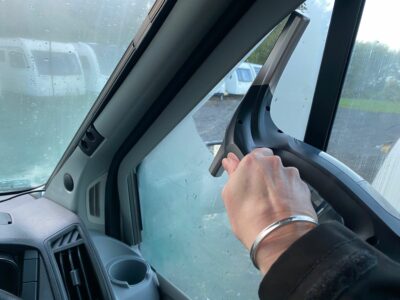
You might find condensation in the back of some lockers, under beds and in areas that have limited airflow. This will reduce over time but do wipe away any excess with a clean microfibre cloth.
When cooking use lids on saucepans and open the windows slightly to let the steam escape.
If your motorhome has a rooflight or extraction fan in the kitchen area, use that to exhaust any steam.
Using gas inside the motorhome also can create some condensation. In this instance, leave a small gap in the window by the kitchen to allow air to circulate.
Hot water obviously creates steam. Again, in the kitchen keep a rooflight or window slightly open.
When using the washroom, such as the shower, keep the washroom window or rooflight open, and close the washroom door to prevent steam from getting into the rest of the motorhome.
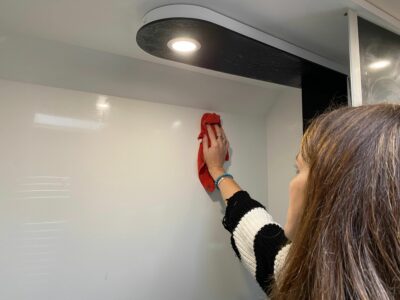
Wipe the walls down when you’re done with a clean microfibre cloth and hang any damp towels in a well-ventilated area.
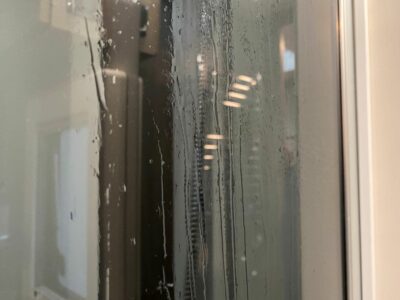

The biggest amount of condensation comes from people when sleeping.
In the morning, open windows that are near the sleeping areas, and wipe excess moisture from walls and windows with a clean microfibre cloth or consider using a handheld window vacuum cleaner to make life easier.
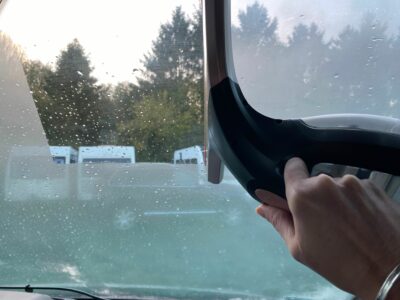
Don’t block off vent holes. Ideally, you want some flow-through of air, with lower and upper-level ventilation around the living quarters. Vents are there for a reason. Many of them are for gas leaks, others for equipment such as furnaces.
Try to avoid bringing wet objects into your motorhome or campervan– from clothing to pets and umbrellas. Dry them off outside before letting them inside your vehicle
Use the washroom for hanging wet clothes, if needed, or better still use an awning or on-site facilities. In the winter and colder month, also consider showering and washing or drying clothes and dishes on the campsite.
If you spill any liquids, mop them up straight away and generally keep cupboards and surfaces clean and dry. Avoid putting anything damp into your lockers and wardrobes.
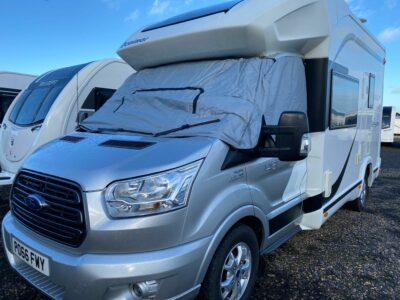
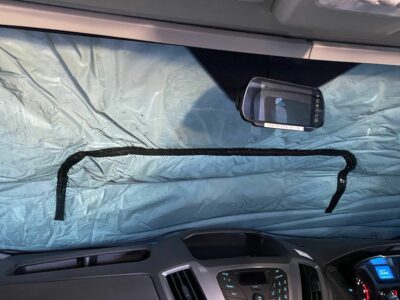
The windscreen on your motorhome is a large area of glass, and a surprising amount of liquid can drip from it. Use silver or thermal screens on the exterior of your motorhome windscreen to reduce condensation within the motorhome cab. On the inside use rolled-up microfibre cloths to collect any excess liquid.
Controlling motorhome damp when in storage
Dehumidifying crystals and moisture traps are an effective, low-cost way of minimising the build-up of damp in your motorhome. There are even hanging, disposable dehumidifiers which you can hang in your wardrobes.
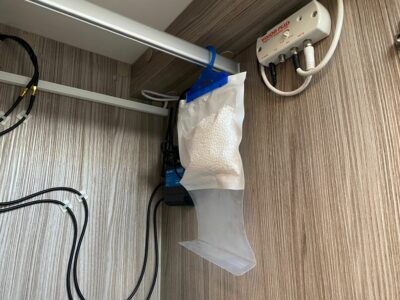
Use moisture traps or de-humidifiers in areas of the motorhome that don’t have good airflow.
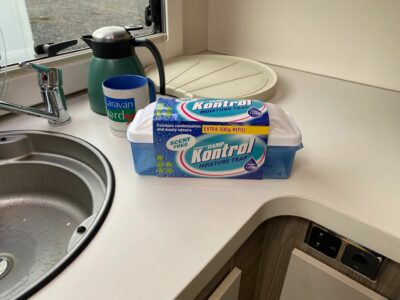
Regular cleaning of your motorhome’s interior will also help. It could even help you detect any early signs of trouble.
If possible, remove all cushions, mattresses, duvets and pillows to a dryer place if you’re not planning on using your motorhome for a while.
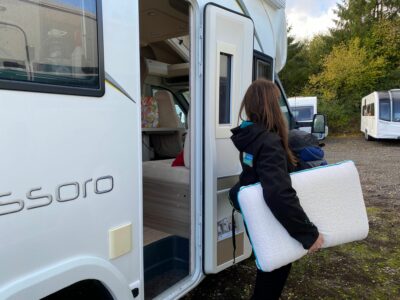
Or turning your seating cushions over periodically and pulling them away from the side of your motorhome will also help and let air circulate around them.
If your motorhome has thick curtains, consider taking them down over winter and keeping them somewhere dry.
When visiting the motorhome in storage, turn on the heating for a short time with the windows open. This will let air circulate inside the motorhome and moisture to escape.
Outside, don’t be tempted to use a power wash when cleaning your motorhome. This can not only damage seals, but any concentrated spray of water can lift or damage sealant, and water can collect inside the habitation area.
It’s also worth checking seals around the windows, doors, rooflights and lockers regularly, as well as awning rails. Look for any signs of water ingress, any dribble marks where liquid might be getting in, and any damage to the seals. Treat them with a silicon spray to keep the seals supple.
Also see our article on controlling water ingress and damp in your motorhome.
Over to you
Got any hints and tips you’d like to pass on to other owners about how to control motorhome damp and condensation? Please feel free to add a comment below.


Thankyou.
Or better still use the MH over the winter lol
Very helpful, especially for the many new owners over the past two years.
Thanks for the feedback Thomas
If you have a 240v electricity supply to your van consider a dehumidifier eg Meaco Zambezi with timer and run it for an hour a day just before dawn with it’s hose leading to a drain eg in the shower. Also use it when sleeping in the van over winter. has the benefit of drying the air as well as providing a small amount of heat. Leave your waste tank drain open to dispose of condensate
Thanks for sharing James
Leave the handbrake off and chock one of the wheels and as Jon White suggested go through the motions with air con as this also can seize up and also run through the gear’s and dip the clutch as this also can seize up
If on hook up, the use of a dehumidifier on the humidistat setting keeps everything bone dry. We take one with us in the winter when its wet outside and you can’t avoid bringing in wet clothing, we hang them in the shower room with the dehumidifier on which dries them in no time.
If you start the unit, give the aircon time to get going too. This will do two things. It will dehumidify the air to some extent and by circulating the coolant in the system, it will reduce the risk of eals drying out.